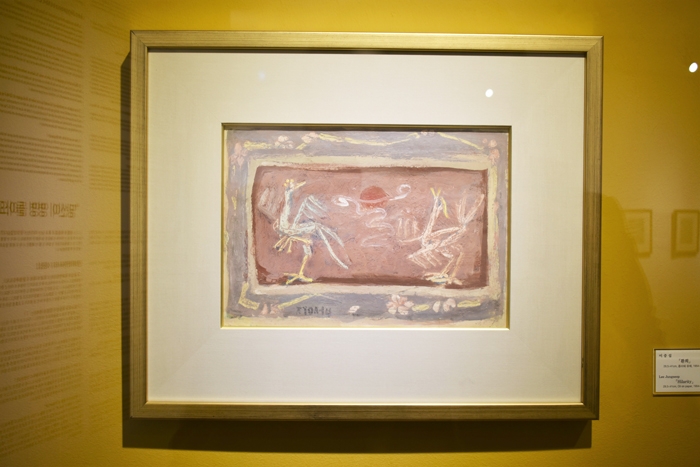1--Imagine Size:18"/24"(45cm/60cm)
2--Framed Size:19.5”/25.5”
3--Signed: Down
4--Provenance: Private Collection In Los Angeles
5--Original: NO Printed, Oil Painting On Woodboard
6--Make your own judgment, Some craquelue in the painting face from age
We are not experts and authorities in "Lee Jung-seop" based only on the sign. The buyer accept to this status and match the description, please look at all pictures before you make a bid, this painting was remind to:
Lee Jung-seop/李仲燮/이중섭 (1916-56) was born in 1916 into a wealthy family in the plain of South Pyongan Province and studied in Pyongyang, Jeongju, and Tokyo. He began his career as a painter in Japan during the Japanese occupation, and was liberated when he returned to Wonsan, South Hamgyong Province. Affected by the Korean War, he took refuge in Jeju Island and Busan, and after the war, he moved to Tongyeong, Seoul, and Daegu, where he devoted himself to writing despite the harsh environment. He died in 1956 at the age of 41.
Despite Korea s modern history, which has been devastated by colonial rule, war, and division, Lee continues to live as an artist. During the Japanese colonial period, he did not hesitate to paint the cow, the symbol of the nation, and left paintings reflecting on the extremely dark reality. Even in the time of poor refuge, he spent happy time with his family and painted flawless beauty. After the war, he created many powerful scalpers with a strong will and confidence. Most importantly, he aspires to become a "righteous painter" who is true to his own sensibility and a "national painter" who discovers the traditional beauty of Korea. However, after being separated from his beloved family, he was cheated into debt and suffered from a mental illness accompanied by anorexia in his old age. Eventually, he died alone, leaving behind a bleak and thin work.
This year marks the 100th anniversary of Lee's birth and the 60th anniversary of his death, and the National Museum of Modern Art is holding a solo exhibition of Lee for the first time in its history. In the turbulent history of Korea, we look back on the "dreams and frustrations" of this talented artist and hope to provide people living today with an opportunity to examine the meaning of life and art.
Lee was born in September 1916 in the plain of South Pyongan Province and attended Jongno Ordinary School in Pyongyang, where his family lived. After that, in 1930, he took a job at Osan High School in Dingju, an art teacher who had graduated from Yale University. The guidance officially began to study fine arts.
In 1936, Lee studied at the Imperial Art School in Tokyo, Japan, and from 1937 to 1941, he studied at the Culture Institute, which was the most liberal private school in Japan at that time. He began to publish his works in the Free Artists Association (renamed the Art Creators Association after 1940), in which his predecessors also actively participated. He won praise from major Japanese critics and gained membership in the association.
In 1941, Lee formed the New Artists Association in Tokyo together with Lee Kwa-dae, Jin Hwan, Choi Jae-deok, Kim Jong-chan, and other artists, and held an exhibition and attracted the attention of the art world.
In 1943, at the height of the Pacific War, he returned to Wonsan, where his family lived, and in May 1945, just before liberation, he married Yamamoto Masako, who had been a student at the cultural Institute.
Having been in and out of the hospital since December 1955, Lee has been living in Seoul with painter Han Mok (1914~), novelist Park Yeon-hee (1918~2008), and poet Cho Yeong-am (1920 ~?). At this time, he drew illustrations for literary and artistic works magazines, and also left works including the series of "The River That Never Returns". However, due to malnutrition and liver inflammation caused by anorexia, he had to be hospitalized again, and died in a Red Cross hospital on September 6, 1956. With the help of friends, his grave and tombstone were built in Neolri Park, Seoul.
Reference Artworks:



